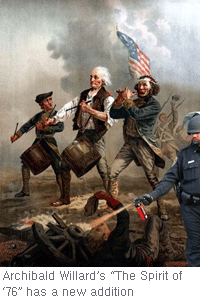 Pepper-spray cop works his way through art history
Pepper-spray cop works his way through art historyLt. John Pike, the U.C. Davis campus police officer who pepper-sprayed passive student protesters, is popping up in some of the world’s most famous paintings as part of an Internet meme intended to shame him for his actions.
The images are a cheeky way of fighting back against what students say was an unwarranted use of forceful policing tactics. The university has defended Pike’s actions, though he and two other police officers have been suspended pending an investigation.
Online, the damage to his and the university’s reputations may already be done: Kennicott says the video will be among the defining imagery of the movement.
Although another controversial image, showing an elderly woman hit with pepper spray near an Occupy protest in Seattle, made this nonlethal form of crowd control an iconic part of the new protest movement, the UC-Davis video goes even further in crystallizing an important question: What does the social contract say about nonviolent protest, and what is the role of police in a democratic society?
Though there are dozens of variations on the pepper-spray cop meme — some inserting him into patriotic moments in history, while others are just mash-ups with other memes — the images of Pike in paintings are effective hyperbole for illustrating his nonchalance in pepper-spraying quiescent protesters.
Though it’s difficult to pinpoint the origins of the meme, the first viral image was Georges Seurat’s “A Sunday Afternoon on the Island of La Grande Jatte.” Through the pointillism painting, Pike strolls, spraying a seated lady in the face.
In a second photoshopped image, Pike appears in John Trumbull's famous painting, “Declaration of Independence.” Pike turns his aim on the document itself. He crosses the Delaware with Washington (while simultaneously spraying the first president in the face) in Emanuel Gottlieb Leutze’s painting.
